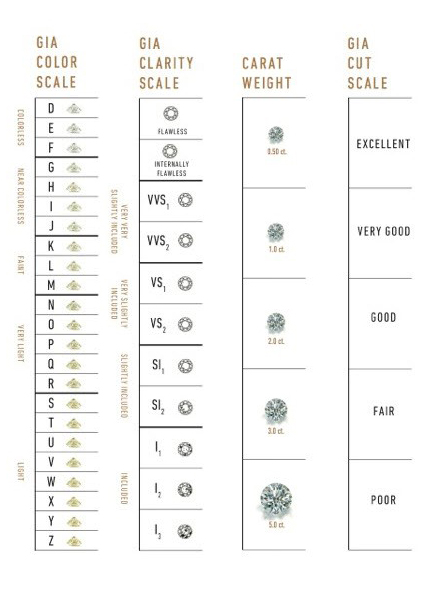Diamond colour unveiled
We value diamonds for their crystal clear and sparkly brilliant nature. The better the cut and clarity, the better the brightness and sparkle of the gem. However, no matter how good the cut or clarity, the body colour of the rough diamond will determine the final white brightness of the gem.
The Gemological Institute of America (GIA) devised a standardised grading system to determine the colour of diamonds. Their grading system was universally adopted by gem laboratories around the world.

Most diamonds will be somewhere between a D colour (that’s the highest colour grade) and an M colour. Although the scale extends beyond that to Z, gems of lesser colour are generally used for industrial purposes rather than made into jewellery. And looking at this picture you can see why.

How do we determine a diamond’s colour?
A trained professional diamond specialist or jewellery valuer will be able to indicate if you have a good colour or lesser colour diamond and give you a general indication, like D-E-F, G-H, I-K, L-M. But to get a precise letter grade, you’ll need a professional diamond grader in a laboratory setting.
A diamond grader will compare your gem to a set of colour grading diamonds and so determine the colour grade. They do this under very specific lighting conditions, in a colour neutral surroundings. Up to and including the graders clothing and equipment needs to be black or white in order to avoid skewing the colour grade.
Besides grading the body colour, the diamond grader will also indicate any treatments that have been performed to improve the diamonds colour. For example some gems are laser treated to remove black spots, have filled fissures to improve clarity, or the gem may have been pressure treated to improve its overall colour.

For gems over 0.5 carat it is wise to get a diamond certificate. For important diamonds or investment pieces we recommend getting a diamond certificate from the GIA laboratory.
So what about coloured diamonds?
After the white diamond, the most common diamond colour is yellow, followed by blue and grey. The rarest are the pinks and red.
Coloured diamonds or fancy diamonds as they are known in the trade - are graded on a different scale altogether. The grading scale works on two axis - the intensity of the colour, but also the hue. The intensity is similar across all colours from faint to fancy vivid. But hue is different for each colour grouping. The scale below illustrates the intricacies of coloured diamond grading for pink-red diamonds

Why are some diamonds coloured?
A diamond’s body colour has to do with the inclusion of trace elements other than carbon in the diamond’s crystal structure as the gem was formed deep in the earth’s mantle. In some cases these are part of the crystal structure of the diamond and change the body colour of the gem throughout. For example Nitrogen leads to yellow and orange diamonds, whereas Boron leads to greys and blues. 
The rarest colours are caused by distortions of the crystal structure or natural irradiation picked up during formation, which affect how light interacts with gem. Crystal structure deformation is prevalent in the pinks and reds from the Argyle mine, whereas radiation picked up towards the end of the diamond’s formation tends to result in green diamonds.
In other cases these are inclusions of other crystals that give the gem the appearance of a different colour, for example Iron specks show a rustic red, and carbon inclusions make a salt & pepper diamond or even a black diamond. Because they are so included they are often fashioned as rose cut gems, rather than brilliant cuts, and also tend to come in more unusual shapes, like kite shapes and broad ovals.
So a gem may be completely transparent, but have a different body colour - for example this fancy chocolate diamond pictured below. Or it may be included with black specks of carbon or needles causing it to look grey or even black - for example the popular salt and pepper diamond.


It is important to note that a fancy coloured diamond has all the characteristics of a white diamond in terms of strength and hardness and lustre and will bring the wearer many years of joy. With diamonds that are coloured due to other crystal inclusions, or heavily included, it is important to examine them carefully to ensure that the mesmerising inclusions that make up a gorgeous rustic gem, don’t cause any structural problems going forward. But don't worry: a carefully selected included diamond will equally last you a lifetime.


Whether you favour the brightest white sparkly gem, or fancy a splash of colour, at DesignYard we have a broad selection of diamonds to soothe your soul. Book your appointment to see the collection.



